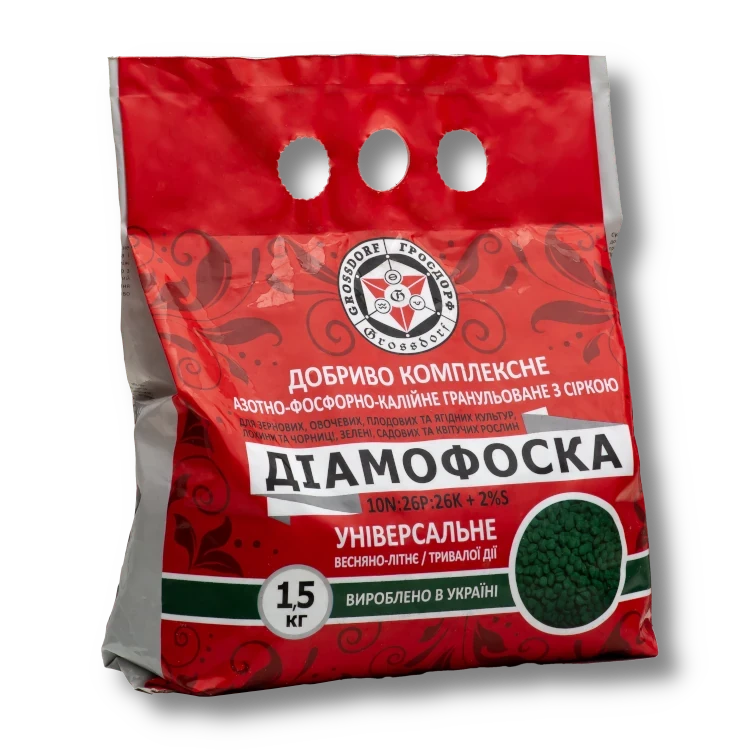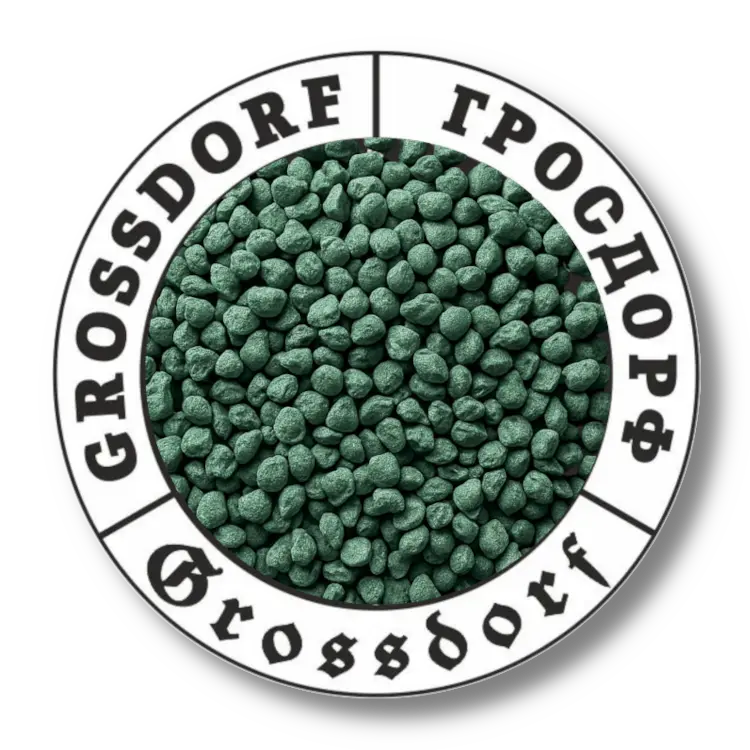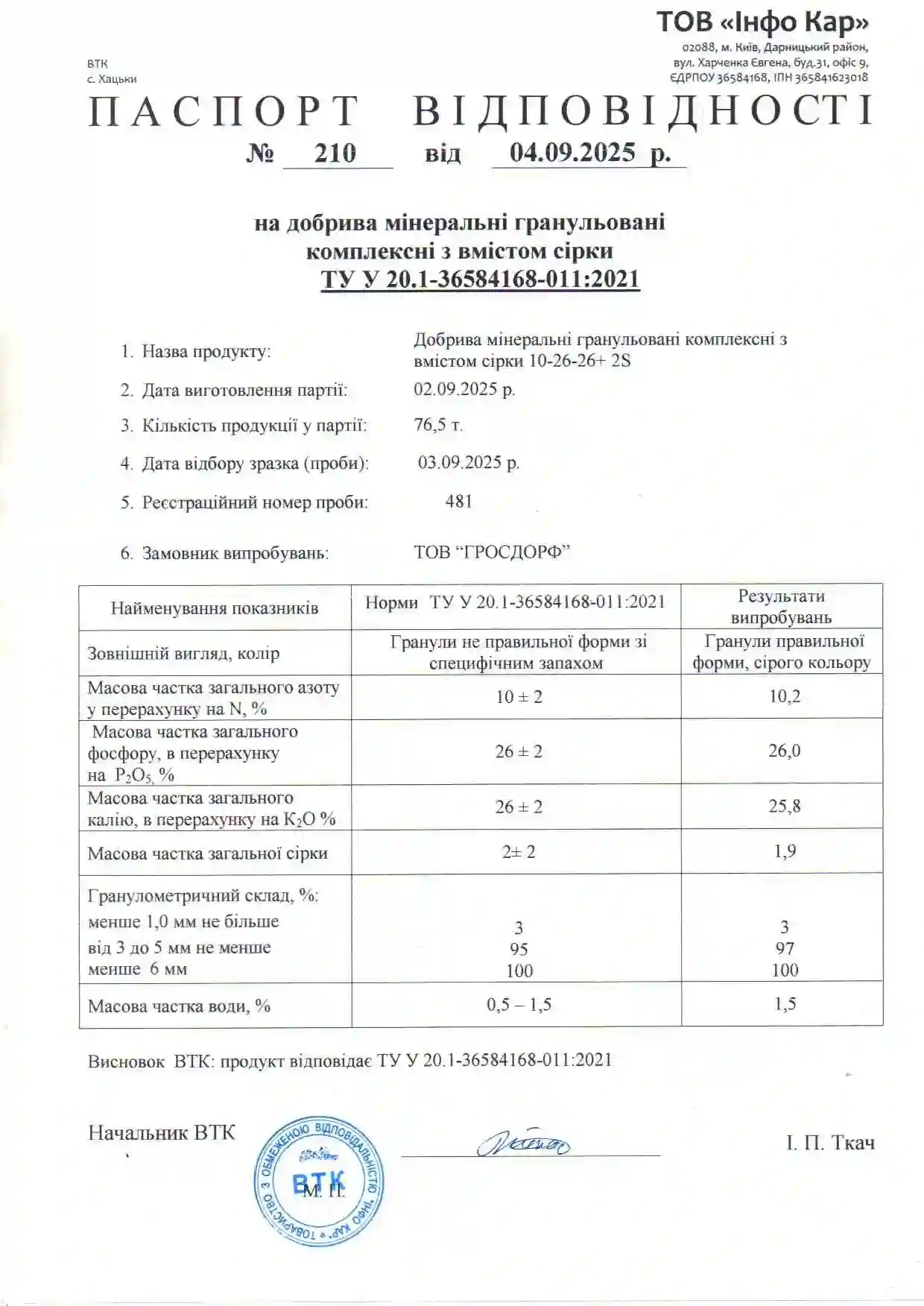Diammonium Phosphate N10:P26:K26+2S
Mineral granular complex fertilizer
with sulfur content “NPK+S 10:26:26+2”
TU U 82.9-36584168-011:2021
Terms of sale/packaging: EXW, FCA, retail packaging 1.5 kg
Delivery terms: by own transport on the territory of Ukraine or by self-delivery
87 UAH
Diammonium Phosphate N10:P26:K26+2S is a concentrated, three-component fertilizer designed specifically for crops with a high demand for phosphorus and potassium. The formula, enriched with sulfur, is ideal for:
- corn, sunflower, potatoes, legumes;
- technical crops;
- vegetables and fruit plantations.
Recommended use:
- pre-sowing application in rows or localized near the root zone;
- main application in autumn or spring;
- especially effective for crops sensitive to phosphorus and potassium deficiency, such as corn, sunflower, rapeseed, beet, potato, legumes, and fruit crops.
Advantages:
- strong starter effect — promotes rapid rooting;
- high potassium content — improves yield quality and dry matter content;
- sulfur inclusion — enhances nitrogen uptake and increases protein levels;
- safe for row application — does not cause salt stress;
- suitable for various soil types — physiologically mildly acidic (pH 5.5–6.5).
Limitations and warnings:
- not recommended for use on waterlogged or swampy soils without liming;
- avoid storage near acids, alkaline agents, or organic fertilizers.
Appearance, color: irregularly shaped granules with a characteristic odor
| Mass fraction of total nitrogen in terms of N, % | 10 ± 2 |
| Mass fraction of total phosphorus in terms of P₂O₅, % | 26 ± 2 |
| Mass fraction of total potassium in terms of K₂O, % | 26 ± 2 |
| Mass fraction of total sulfur, % | 2 ± 1 |
| Granulometric composition, % | |
| Less than 1 mm no more | 3 |
| 3 to 5 mm not less than | 95 |
| less than 6 mm | 100 |
- store in dry, well-ventilated facilities, protected from direct sunlight, with relative air humidity not exceeding 70%. Place bags on pallets at least 15 cm above the floor, arranged in a single layer;
- packaging (bags, big bags) must be tightly sealed to prevent moisture ingress;
- permissible storage temperature: from –20 °C to +35 °C (avoid exposure to high humidity, as this may cause caking or condensation — loosen before use if necessary);
- avoid contact with acids, alkaline substances, organic compounds, or other fertilizers that may cause a chemical reaction;
- in case of prolonged storage, periodically loosen the product to prevent clumping.
Shelf life: 12 months from the date of manufacture if transportation and storage conditions are met. After the warranty period expires, the product must be tested for compliance with the technical specifications before use.
| Culture | Application period /rate, kg/are | Special application conditions | |||
|---|---|---|---|---|---|
| Pre-sowing cultivation | First fertilization | Second fertilization | Third fertilization | ||
| Cereal сrops | |||||
| Winter wheat | 1,4-3,0 | - | - | - | applied in autumn before plowing or deep digging |
| - | 0,4-0,6 | - | - | at sowing, into the rows | |
| Maize | 3,5-4,6 | - | - | - | applied in autumn before plowing or deep digging |
| 2,3-3,8 | - | - | - | during pre-sowing cultivation | |
| - | 0,2-0,4 | - | - | at sowing, into the rows | |
| Spring barley | 1,7-2,3 | - | - | - | in autumn during ploughing/digging or before sowing |
| - | 0,4-0,6 | - | - | at sowing, into the rows | |
| Oats | 1,7-2,3 | - | - | - | in autumn under plowing/digging or pre-sowing cultivation |
| - | 0,4-0,6 | - | - | into rows before sowing | |
| Industrial crops | |||||
| Sunflower | 3,0 | - | - | - | during primary tillage or before sowing |
| 0,5 | - | - | - | at sowing, into the rows | |
| Sugar beet | 3,0 | - | - | - | during primary tillage or before sowing |
| 0,5 | - | - | - | at sowing, into the rows | |
| Oilseeds | |||||
| Winter rape | 3,0 | - | - | - | during autumn (fallow) tillage or before sowing |
| 0,5 | - | - | - | at sowing, into the rows | |
| Soybeans | 2,0 | - | - | - | during primary tillage or before sowing |
| Oil flax | 2,5 | - | - | - | during autumn (fallow) tillage or before sowing |
| 0,5 | - | - | - | at sowing, into the rows | |
| Vegetables | |||||
| Tomatoes | 2,0-3,0 | - | - | - | before plowing or during pre-sowing cultivation (if no further fertilization is planned) |
| 1,0-1,5 | - | - | - | when planning fertilization | |
| 0,5 | - | - | - | during seedling transplanting | |
| - | 0,8 | - | - | 10 to 14 days after seedling transplanting | |
| - | - | 0,8 | - | during flowering | |
| Peppers | 2,7-3,0 | - | - | - | before plowing or during pre-sowing cultivation, if no further fertilization is planned |
| 1,0-1,5 | - | - | - | when planning fertilization | |
| 0,8 | - | - | - | during planting | |
| - | 0,8 | - | - | 10 to 12 days after seedling transplanting | |
| - | - | 0,8 | - | during flowering | |
| - | - | - | 0,8 | during fruit formation | |
| Zucchini | 3,5-4,6 | - | - | - | before plowing or during pre-sowing cultivation, if no further fertilization is planned |
| 1,7-2,9 | - | - | - | when planning fertilization | |
| 0,6 | - | - | - | at sowing, into the rows | |
| - | 0,8 | - | - | during flowering | |
| - | - | 0,8 | - | at the beginning of fruiting | |
| Cucumber | 2,3-3,5 | - | - | - | before plowing or during pre-sowing cultivation, if no further fertilization is planned |
| до 1,2 | - | - | - | when planning fertilization | |
| 0,4 | - | - | - | at sowing, into the rows | |
| - | 0,8 | - | - | at the 3–4 leaf stage | |
| - | - | 1,2 | - | complete before vine spreading begins | |
| Aubergine | 1,2-3,5 | - | - | - | under plowing or cultivation (if no other fertilizations are planned) |
| 2,0 | - | - | - | when planning fertilization | |
| 0,6 | - | - | - | during seedling transplanting | |
| - | 0,8 | - | - | 10–12 days after transplanting | |
| - | - | 0,8 | - | 10–12 days after the first fertilization | |
| Potatoes and other root crops | |||||
| Potatoes | 2,3-4,6 | - | - | - | applied in autumn before plowing or deep digging |
| 2,3-3,8 | - | - | - | during pre-sowing cultivation | |
| 0,4-0,8 | - | - | - | at sowing, into the rows | |
| Table beet | 2,3-3,5 | - | - | - | in autumn under plowing or digging, or into pre-sowing cultivation |
| 0,4-0,8 | - | - | - | at sowing, into the rows | |
| Carrots | 2,3-3,5 | - | - | - | in autumn under plowing or digging, or into pre-sowing cultivation |
| 0,4-0,8 | - | - | - | at sowing, into the rows | |
| Radish | 2,3-3,8 | - | - | - | in autumn under plowing or digging, or into pre-sowing cultivation |
| 0,4-0,8 | - | - | - | at sowing, into the rows | |
| Onion | 2,3-3,5 | - | - | - | under plowing or into pre-sowing cultivation, if no other fertilizations are planned) |
| 1,4 | - | - | - | when planning fertilization | |
| 0,6 | - | - | - | at planting | |
| - | 0,8 | - | - | 10–14 days after emergence | |
| - | - | 0,8 | - | at the bulb formation stage | |
| Garlic | 2,3-3,5 | - | - | - | under plowing or into pre-sowing cultivation, if no other fertilizations are planned) |
| 1,0-2,1 | - | - | - | when planning fertilization | |
| 0,58 | - | - | - | at planting | |
| - | 0,8 | - | - | at the beginning of clove formation | |
| Fruit trees and berry trees | |||||
| Apple tree | 5,4 | - | - | - | fertilization in autumn |
| Pear tree | 4,2 | - | - | - | fertilization in autumn |
| Cherry tree | 5,4 | - | - | - | fertilization in autumn |
| Raspberry | 3,0 | - | - | - | fertilization in autumn |
| Wild Strawberry/Garden Strawberry | 3,0 | - | - | - | fertilization in autumn |
| Grapes | 0.025 kg per 1 m² | - | - | - | into root zones in spring |
| Blueberry | Fertilization should be carried out twice a year: at the beginning of the growing season (April) and at the end (August–September). After planting: 2nd year – 1 tablespoon, 3rd year – 2 tablespoons, 4th year – 4 tablespoons, 5th year – 8 tablespoons, 6th year and beyond – 16 tablespoons or 40–50 g per mature bush | ||||
| Flowers and lawn grasses | |||||
| Rose | 1,5-2,0 | - | - | - | applied in autumn before plowing or deep digging |
| 0,015-0,020 | - | - | - | into the planting hole | |
| - | 0.010 per 10 liters of water | - | - | after pruning and before the emergence of the first leaf | |
| - | - | 0,010 per 10 liters of water | - | during the period of intensive growth, full bloom, and second flowering | |
| Tulips | 4,0 | - | - | - | one month before planting, during ploughing/digging |
| - | 2,0 | - | - | At the bud formation stage, apply into furrows 8–10 cm deep between plant rows, followed by incorporation into the soil. | |
| Lawn grasses | 2,5-3,0 | - | - | - | in autumn before lawn establishment |
| - | 1,7 | - | spring or summer fertilization (June–August) | ||
| Conifers | |||||
| Boxwood | 3,0 | - | - | - | in spring (April–May) at 30 g/m² |
| 1,0 | - | - | - | at planting, into the hole, 10 g/m² | |
| Juniper | 2,5 | - | - | - | in spring (April–May) at 25 g/m² |
| 0,5 | - | - | - | at sowing, into the hole, 5 g/m² | |
| Thuja | 2,5 | - | - | - | in spring (April–May) at 25 g/m² |
| 0,5 | - | - | - | at planting, into the hole, 5 g/m² | |
Note: It is best to fertilize all fruit and berry plants with complex fertilizers in spring, followed by soil digging. When feeding trees, it is recommended to incorporate the fertilizer into the soil at a depth of 8–10 cm.
The fertilizer application rates were developed by the Department of Agrochemistry and Soil Science of Uman National University of Horticulture under the scientific supervision of Doctor of Agricultural Sciences, Professor Hospodarenko H.M., commissioned by AC Grossdorf. These recommendations are the intellectual property of AC Grossdorf and may be distributed only with proper attribution to the owner.
The provided application rates are generalized and do not replace the need for consultation with an agronomist.


